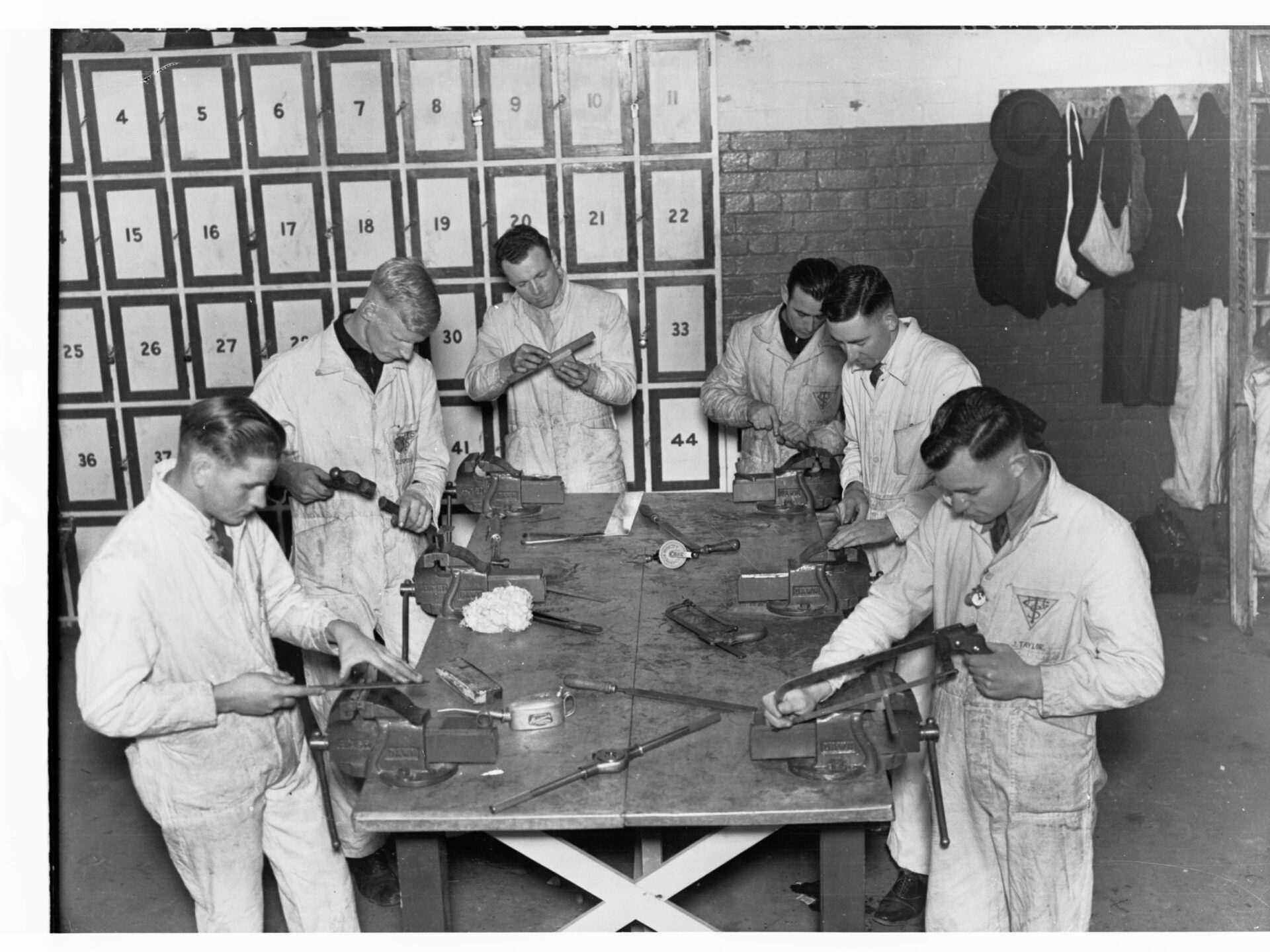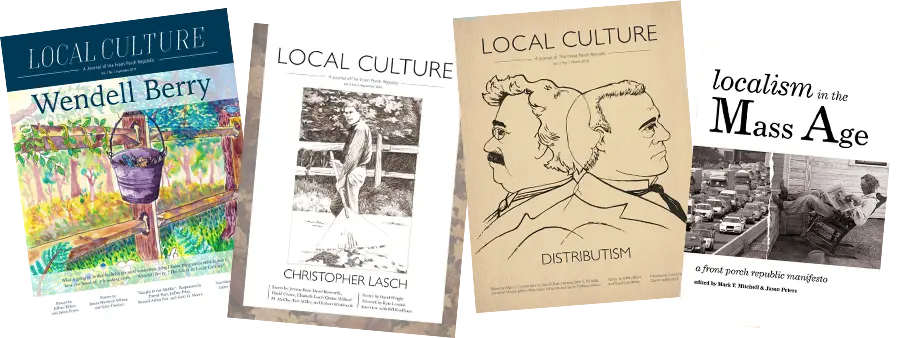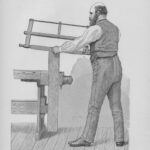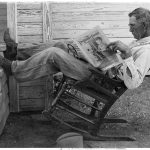This summer, a machinist with a law degree named Darnell Epps attracted considerable attention following the appearance in a major newspaper of his op-ed on the “untapped potential of skilled trades.” Ten days after its publication, Epps headlined a special segment on a CNN show that addressed the same topic, and two weeks later he was one of three panelists in an hour-long discussion on NPR. The quantity of comments on the op-ed and the number of callers into the interview suggested that more than a few people agreed with him.
Epps’s argument that the vocational aspects of an education are as valuable as the academic ones has been around at least since the days of Jane Addams and John Dewey. It’s also been controversial: does it encourage or discourage socio-economic mobility? But practical schooling has acquired new relevance in our post-pandemic economy, and past questions about its intentions – whether it limits or enhances student aspirations – have drawn little attention. Many students and teachers now seem to agree that learning a trade is a more affordable and accessible way to begin a career than acquiring a college degree. And there is growing interest in the less pecuniary benefits of manual training: as woodworker Doug Stowe has argued in these pages, learning to work with the hands is a defense against the confusion that abounds on social media.
When manual work was introduced into schools over a century ago, its chief advocates were social reformers distressed by the number of early adolescents who dropped out of school prior to getting the education that good citizenship required. Today, it’s the students themselves who want a practical education.
Covid is among the causes. The pandemic was a “wake-up call,” claimed the head of a public vocational school in Florida who was interviewed on the NPR show. His school’s enrollment picked up as people began emerging from isolation, and its growth “has been vertical since then.” Another panelist noted that the job market is “oversaturated with college grads.” Young people today want to get career-preparation done more quickly and with less expense; one caller claimed he went to trade school so that he could start paying off a mortgage rather than student loans.
Epps, the man whose op-ed instigated this media attention, had arrived at a promising career via a circuitous route, one that tells another story about an education in useful knowledge. In June, he’d received a degree from Yale Law School; two years earlier, he’d received a diploma from Lincoln Technical Institute near his home in New Haven. Adding to these distinctions is another: some of his prior education had been acquired at Cornell University, not on its campus but as part of a prison-education program; he had been incarcerated at age 20 for his role in a gang altercation that left another young man dead. His goal now is to build a software-driven company that leads people into good careers in the skilled trades and manufacturing.
The route Epps took toward his trade school diploma harkens back to an older American tradition that regarded manual work as a part of schooling. Beginning in the 1820s, schools such as Rensselaer opened, offering courses in mechanics and other applied sciences. In the 1830s, men like the charismatic abolitionist Theodore Weld promoted “manual labor in literary institutions”; the idea was that young men could work their way through seminary tending to livestock and harvesting crops in college-owned fields. Oberlin got its start that way.
Then, in the 1840s, manual labor and instruction in learning a trade was adopted by reform schools and penal institutions. It was believed that the acquisition of skills would not only restore the souls of those who had run afoul of the law, but would also give them a way to make an honest living. In the 1850s, Jonathan Baldwin Turner, a biology teacher at one of the manual labor schools in Illinois, promoted the establishment of a university that would instruct thinkers in doing and doers in thinking. The result was Illinois Industrial University, which opened in 1867; later it became the University of Illinois.
Epps’s education and the rationale behind his firm call back to Turner’s idea that thinking and doing are complementary; that all people should be able to function in both concrete and abstract realms. The detour he took between high school and college illustrates another issue: by the time Epps had entered his teens, many of the vocational programs established in high schools a century earlier had been eliminated. The idea was college for all. The reality was that young people uninterested in higher education dropped out, thus lacking both academic and vocational skills. And many of them, unable to find legitimate jobs, were instead trapped into illegal ones, often leading to incarceration.
This situation became apparent to me when I taught in a prison education program managed by a New Jersey community college. My question, as I engaged with some of the most dedicated students I’ve ever had, was: why are they on the inside when I can come and go? The answer is complicated, but one of the reasons was that there were no shop classes in the schools of Trenton and the other cities that fed young men into the prison in Rahway, where I met my students. I learned a poignant lesson while helping a 14-year-old Trenton boy do math: he had no idea what a lathe, a level, or a blueprint were.
Had he been fortunate enough to attend a school like the state-supported Manual Training and Industrial School (MTIS) in Bordentown, 10 miles south of Trenton, not only could he have learned how to use a lathe and a level and acquired the skills to become a carpenter or a mechanic, but he would also have received a sufficiently solid academic education to prepare him for college were that his choice. But MTIS closed in 1955, a consequence of the state’s determination to integrate its schools, and of a growing opposition to vocational education for anyone, regardless of race.
Once called a “star of hope” by a New Jersey superintendent of education, MTIS was founded in 1886, a product of several forces. One was a young minister’s dedication to providing solid schooling for Bordentown-area children living in unstable homes. Another was a broader movement, one that had begun during the 1876 Centennial Celebration in Philadelphia, when some U.S. educators decided to adopt an efficient method of instruction in tool use they had seen on display at a Russian exhibit. That determination led to manual training programs in Missouri and Massachusetts and elsewhere. Supporting the Bordentown minister’s effort was an organization called the Colored Technical and Industrial Education Association, linking it in concept with the schools in St. Louis and Cambridge.
Two years earlier, in 1884, the Chicago Manual Training School (CMTS) had opened its doors. Modeled in part after the Manual Training School in St. Louis, two of its founders had graduated from colleges established on the manual labor model advocated by Theodore Weld. One was in Illinois and another, which eventually became Grinnell, was in Iowa. CMTS soon became a model for schools in other cities, among them Toledo and Baltimore. Like New Jersey’s MTIS, these schools adopted a pattern established in St. Louis – academic courses in the morning and courses in drawing, tool use, metal work, and carpentry in the afternoon. By combining the law courses he took during one part of the week with the machine tool courses he took at other times, the program Darnell Epps set for himself was not too different.
By 1890, public schools in Milwaukee and Chicago, Philadelphia, Cleveland, and elsewhere were offering manual training programs to complement academic work in their secondary schools. Other schools, often those in rural areas, were adopting a method imported from Scandinavia known as sloyd; with its focus on manual dexterity, it was popular as a method of teaching handicrafts. Kindergartens, another import from Europe, were established in middle-class neighborhoods across the country, attracting mothers and their young children to lessons in creative play with objects. All were aspects of the growing recognition that hand work complements head work
Best known among these efforts was the experimental school opened in 1896 by John Dewey at the University of Chicago. Soon called the Laboratory School, its curriculum not only combined mental and manual work, heads and hands, it used the idea of occupations – the work people do to sustain themselves and their communities – as the foundation for teaching academic subjects. Students learned math through carpentry, chemistry through food preparation, and biology through nature study. As the century turned, the university tried to merge CMTS with the Laboratory School and a few other pre-collegiate institutions into one grand School of Education in Chicago.
Dewey soon found that idea unworkable and left for Columbia University in New York in 1904. Among his colleagues there was a young man named Charles Richards, who directed the industrial education program at neighboring Teachers College. Responding to a growing consensus that hand work belonged in schools along with head work, Richards led the establishment in 1906 of the National Society for the Promotion of Industrial Education. Jane Addams, along with union leaders, university presidents, and heads of major corporations, was on its first board. Its goal: federal legislation that would help states fund industrial education programs in high schools nationwide. This was eventually accomplished, with the passage of the Smith-Hughes Act in 1917.
Of course, there were important disagreements within this broader tradition. Dewey and other humanist educators advocated programs that would expand the students’ understanding of the world and their role in it; “industrial intelligence” it was called. In Dewey’s famous phrase, students would be, so far as possible, “masters of their own industrial fate.” Others, taking a more utilitarian view, felt society would be best served if students were tested and then some authority would determine the type of work each should have. Their schooling would be limited to exactly those skills and procedures required by such a job.
The humanists argued for a comprehensive high school, one that combined both academic and vocational curricula; the utilitarians for two sets of schools – academic schools for the college bound and vocational schools for the rest. What happened was the bifurcation of the comprehensive high schools along class lines. Instead of the program pioneered by CMTS and MTIS forty years earlier, students from middle-class families followed an academic program, while those from families with fewer advantages were directed into technical and vocational ones.
By the 1950s, this difference was particularly stark. The late historian Herbert Kliebard recalled his years teaching at that time, first in a vocational school in the Bronx and then at a suburban high school. This “bi-furcation” led to an “opportunity gap tied to social class as well as race and gender,” he wrote.
Then came the revisionism of the 1960s. Recognizing that history is often told by the victors, some young historians of education began to focus on those they felt were victims of public schooling. In the 1970s, several books about industrial education were published; few regarded it positively. But their criticisms tended to focus on policy pronouncements from national organizations rather than on the histories of actual schools and programs that had been established decades earlier. Overall, these critics suggested that the Progressive Era educators, union heads, and business leaders who supported industrial education could not agree on what skills should be taught, so the movement simply lost momentum.
As an outcome of the Civil Rights Movement, industrial education for Black students received particular scrutiny. The differences between the vision of Booker T. Washington as represented by Tuskegee Institute in Alabama and the aspirations of W.E.B. Du Bois were often exaggerated. Arguably, Washington and Du Bois were more complementary than antagonistic (see the latter’s 1932 essay “Education and Work”). MTIS, once a model institution, was closed by the state. In doing so, New Jersey’s governor claimed, wrongly, that Bordentown was “not much of an educational institution.” Its elegant campus eventually housed a correctional facility for young people.
Despite disagreements about vocational education’s virtues or value, Congress continued to generously support such programs, all of which were managed through matching funds by states. Larry Cuban, an educator and historian of broad experience, noted in a 1982 article that, despite their apparent popularity, many of these programs had notable defects and small enrollments. Potential critics, he felt, were ignoring them rather than giving these programs the careful analysis they deserved. Nevertheless, in 1984, the authorization became the Perkins Act and was passed almost unanimously. In 2006, vocational educators began identifying themselves as career and technical educators, and in 2018, the Perkins Act was reauthorized until 2024. Its fate today is uncertain.
Despite this record of success, the situation Dewey warned against had come to pass. Though comprehensive high schools dominated public education nationwide, their industrial arts programs have been dropped in preference for college prep. The public systems’ abandonment of vocational education let it become the province of for-profit schools, which were usually more interested in profit than in schooling. The resulting dearth of manual training in public schools has been lamented by many, perhaps most audibly by political philosopher and motorcycle mechanic Matthew Crawford in his widely acclaimed 2009 book Shop Class as Soulcraft.
However, as the response to Darnell Epps’s op-ed and to the subsequent NPR show suggest, young people could be asking that shop class come back and be more widely available. Some writers have taken up the cause, as Danielle Drelinger did in her 2021 Secret History of Home Economics, a book that ended with a plan for re-imagining how the science and technology once associated with domestic pursuits might be re-configured for a global economy.
Two years later, New York Times columnist Pamela Paul argued that courses in shop and home economics would better prepare young people for the future. Her arguments were similar to those of a century ago: manual work enhances academic performance. “Kids need a break,” she wrote. Minds can work along with bodies, whether learning to hit a nail or bake a cake. These are “adulting” skills: hand work requires patience; cleaning up collaboratively enhances social skills.
Listeners who called into the NPR show would agree. Skills learned in shop class, trade schools, and workforce education in community colleges can respond to students’ aspirations and to their financial concerns. Jobs in construction, health care, and manufacturing technology need not lead to dead ends, and as the Florida school official noted, baby-boomers are retiring, creating a “vacuum at the bottom end” that opens up multiple possibilities for the future.
It may be that building a healthy post-pandemic economy requires us to rejuvenate the manual training school model that led all students to acquire both academic and industrial skills. And perhaps there is more to it than economics. Doug Stowe argues that learning to work with the hands prepares students to “discover and test truth firsthand.” Thus, manual training might also be a bulwark against the fakery of our screen-addled age. The hands have a particular role in this, Stowe has claimed: “whereas eyes and ears are easily deceived, . . . hands measure the weight, size, density, and texture of objects.”
Now as in the past, the work of the hands not only complements the work of the head: it may be essential to keeping our brains on the level.
Image via Wikimedia Commons
The following publications and broadcasts are referred to in the foregoing.
Crawford, Matthew. Shop Class as Soulcraft: An Inquiry into the Value of Work. New York: Penguin Books, 2009.
Cuban, Larry. “Enduring Resiliency: Enacting and Implementing Federal Education Legislation,” in Harney Kantor and David Tyack, eds., Work, Youth and Schooling: Vocationalism in American Education. Palo Alto: Stanford University Press, 1982.
Drelinger, Danielle. The Secret History of Home Economics: How Trailblazing Women Harnessed the Power of Home and Changed the Way We Live. New York: W.W. Norton, 2021.
Du Bois, W.E.B. “Education and Work,” Journal of Negro Education I, no. 1 (April 1932): 60-74.
Epps, Darnell. “I Went to Trade School During Law School, It Left Me Stunned,” Op-ed, Washington Post, June 23, 2024. https://www.washingtonpost.com/search/?query=Darnell+Epps
—– “The Prison Old-Timers Who Gave Me Life,” Op-ed, New York Times, October 6, 2018. https://www.nytimes.com/2018/10/06/opinion/sunday/aging-inmates-prisons-mandatory-sentencing.html?searchResultPosition=1
1A @ WAMU; NPR interview show hosted by Jenn White, July 17, 2024.
Kliebard, Herbert. Schooled to Work: Vocationalism and the American Curriculum. New York: Teachers College Press, 1999.
Paul, Pamela. “To Prepare Kids for the Future, Bring Back Shop and Home Ec,” Opinion, New York Times, October 12, 2023. https://www.nytimes.com/2023/10/12/opinion/school-manual-labor-shop.html?searchResultPosition=1
Smerconish, CNN show hosted by Michael Smerconish, July 6, 2024.
Stowe, Doug, “AI, Misinformation, and Manual Arts Training,” Front Porch Republic, online, January 19, 2024. https://www.frontporchrepublic.com/2024/01/ai-misinformation-and-manual-arts-training/
—– “A Garden of Children,” Front Porch Republic, online, July 2, 2024. https://www.frontporchrepublic.com/2024/07/a-garden-of-children/
Connie Goddard, Ph.D., is a journalist; parts of this article are based on her forthcoming book Learning for Work: How Industrial Education Fostered Democratic Opportunity, to be published in September 2024 by the University of Illinois Press.







1 comment
Brian Miller
Connie,
I certainly appreciated this piece. And I have echoed in my private life a similar argument with young people that they are better off pursuing the trades (particularly men). What stuck with me after reading this essay, though, was the effort of the managerial/expert class near constant effort to social engineer the citizenry throughout the years; Do this, do that. Is it any wonder that the general population seems heartily suspicious of all expert opinion these days?
Thanks again for such a thoughtful piece,
Brian
Comments are closed.